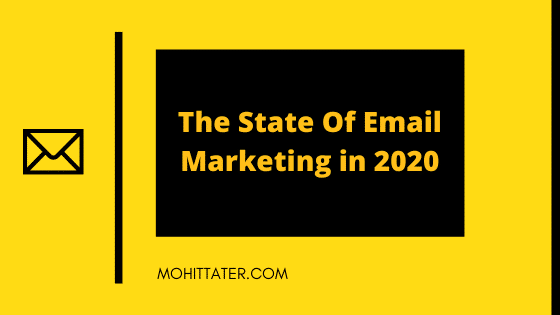The State Of Email Marketing in 2020
It is estimated that more than 3.5 billion people in the world have access to email. This essentially forms almost 50% of the entire global population. As such, it is understandable why email has always been one of the favorite platforms of internet marketers. If you plan to make the most of email marketing, then there are many things you need to keep track of, including the latest and emerging trends and techniques. In this article, we will focus on the state of email marketing today, which should give you a good idea of its potential and how you can position yourself to take advantage of its possibilities.
1. Current Trends
According to a report by one of the leading email marketing platforms, GetResponse, current trends indicate that marketing through email remains a hugely profitable venture for any internet marketer. The report was created after a survey of more than 2,500 email marketers and revealed the following facts:-
i. Highly Effective Digital Media Channel
Email marketing was rated as having the highest effectiveness among all available digital marketing channels, getting an ‘excellent’ rating from 18.2% and ‘good’ from 35.4% of participants. Interestingly, direct mail was only seen as ‘excellent’ by 9.9% of people, which essentially means that email marketing is almost 50% more effective when compared to direct mail. The closest channel that was said to perform as well as email marketing was social media marketing, which was rated as ‘good’ by 33.5% of participants.

ii. Areas Where Email Marketing Proved To Be More Impactful
Although email marketing was rated as highly effective by participants, the method was said to perform more better in certain areas. For example, 23% of the participants stated that email marketing was very effective in generating leads. However, only 17% admitted to having had their conversion rates improve through emails. And in fact, only 3% stated that email marketing leads to a shorter sales cycle. As such, internet marketers are expected to use emails as a tool to get more new leads while focusing on a combination of other digital strategies to convert those leads into sales. Almost 58% respondents projected that they would increase their email marketing budget, while just 7.8% said that they were considering to reduce the budget.
iii. Targeting Techniques
Though it is widely believed that most email marketers use some kind of targeting techniques in order to get the best response from visitors, the report highlighted the exact opposite. 50% of the participants said that they never used any targeting technique while sending an email – they just send their message to all members of their list without categorizing them into any groups. Only 7% of the marketers used highly detailed targeting techniques, which took into account various criteria like demographics, activity level and behaviors of the list members in order to send personalized emails. This, of course, signifies a vast amount of optimization is still pending for many email marketers.
iv. Subscriber List Management
The report also gave an insight into how marketers manage their email lists. Almost 53% of the survey participants claimed to use multiple tools for building up their list and boost their lead generation activities. However, 24% of the marketers said that they never actively managed the list in any way and that no one in particular was responsible for the list. Only 8% of the respondents stated that they used progressive profiling tactics to create profiles of their subscribers.
2. Emerging Trends
i. AI Email Campaigns
With Artificial Intelligence making deep impacts in every industry, it was inevitable that email marketing will be affected. One of the early adopters of AI-driven email campaign service is Adobe, whose AI can suggest the best subject headlines to the marketers. What’s more, it can also tell you which images to use in order to have the maximum positive impact from your subscriber list.
ii. Mobile Focus

Image by Joas Silas via Unsplash
Do you know that more than 50% of emails are accessed through a mobile device? If not, then this is a statistic that you should definitely keep in mind. Many email marketers, especially newbies, make the mistake of only creating emails that will be displayed properly on desktops. As such, when a user views such emails on their mobile device, it will look disjointed and out of order. As a result, a lot of people will not be impressed with your email. So, make sure that when you format your email, do it in a way that it looks perfect on mobile screens as well, i.e. make it responsive.
iii. Interactive Emails
The internet is becoming more interactive. And people actually prefer more interactive content on the pages they visit and the mails they get. After all, why sit and just passively watch something when you can interact and have fun with it? This shift affects email marketing tactics. This essentially means more use of things like polls, quizzes, galleries, and other such interactive elements in the email. By making people interact with the elements of the email, you will be creating a relationship between the user and the email message, which increases the chance that they might be willing to further explore your offer.
iv. Plain Text Emails
Together with interactive emails, a curious development has been the increasing popularity of plain old text emails. As such, HTML templates full of well-designed images are being ditched in favor of simple, textual content. This mostly has to do with the fact that people nowadays look to consume media in the simplest way possible. And the presence of unwanted graphics usually take the attention of the user away from the message.
In addition, emails with too much graphics might not look good on tiny mobile screens. In contrast, text-based emails look the same on every single device, whether you are using a tablet, smartphone, or desktop. And given this benefit, it should be understandable why some marketers are increasingly using text-based emails in their marketing campaigns. So, get a good copy-writer to create some persuasive content for your next email campaign.

